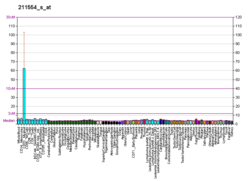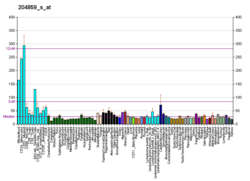APAF1
(Apaf-1から転送)
APAF1(apoptotic peptidase activating factor 1)はアポトーシスに関与するタンパク質で、線虫Caenorhabditis elegansのCED-4のヒトホモログである[5][6][7]。
機能
編集APAF1遺伝子は、アポトーシス調節ネットワークの中心的なハブの1つを形成する細胞質タンパク質をコードする。APAF1タンパク質は(N末端から)CARDドメイン、ATPアーゼドメイン(NB-ARC)、短いヘリカルドメイン、そして数個のWD40リピートドメインを含む。シトクロムcとdATPの結合に伴って、オリゴマーからなるアポトソームを形成する。アポトソームはカスパーゼ-9前駆体を結合して切断し、成熟した活性化型として放出する。この反応の正確な機構については未だ議論があるが、アポトソームはカスパーゼ-9の二量体化を誘導し、その後に自己触媒が行われることが示唆されている[8]。活性化されたカスパーゼ-9はその後カスパーゼカスケードを刺激し、細胞をアポトーシスに従事させる。
選択的スプライシングによって、異なるアイソフォームをコードする7種類のバリアントが産生される[5]。
構造
編集APAF1は6本のヘリックスからなるグリークキーモチーフを持つCARDドメイン、ロスマンフォールド型のヌクレオチド結合ドメイン、短いヘリカルモチーフ、ウィングドヘリックス(winged-helix)ドメインを含む[9]。
相互作用
編集APAF1は次に挙げる因子と相互作用することが示されている。
出典
編集- ^ a b c GRCh38: Ensembl release 89: ENSG00000120868 - Ensembl, May 2017
- ^ a b c GRCm38: Ensembl release 89: ENSMUSG00000019979 - Ensembl, May 2017
- ^ Human PubMed Reference:
- ^ Mouse PubMed Reference:
- ^ a b “Entrez Gene: APAF1 apoptotic peptidase activating factor 1”. 2021年11月7日閲覧。
- ^ “Apaf-1, a human protein homologous to C. elegans CED-4, participates in cytochrome c-dependent activation of caspase-3”. Cell 90 (3): 405–13. (Aug 1997). doi:10.1016/S0092-8674(00)80501-2. PMID 9267021.
- ^ “Assignment of apoptotic protease activating factor-1 gene (APAF1) to human chromosome band 12q23 by fluorescence in situ hybridization”. Cytogenetics and Cell Genetics 87 (3–4): 252–3. (1999). doi:10.1159/000015436. PMID 10702682.
- ^ “The apoptosome activates caspase-9 by dimerization”. Molecular Cell 22 (2): 269–75. (Apr 2006). doi:10.1016/j.molcel.2006.03.009. PMID 16630894.
- ^ “Structure of the apoptotic protease-activating factor 1 bound to ADP”. Nature 434 (7035): 926–33. (Apr 2005). doi:10.1038/nature03465. PMID 15829969.
- ^ a b “Induced inhibition of ischemic/hypoxic injury by APIP, a novel Apaf-1-interacting protein”. The Journal of Biological Chemistry 279 (38): 39942–50. (Sep 2004). doi:10.1074/jbc.M405747200. PMID 15262985.
- ^ a b “Bcl-XL interacts with Apaf-1 and inhibits Apaf-1-dependent caspase-9 activation”. Proceedings of the National Academy of Sciences of the United States of America 95 (8): 4386–91. (Apr 1998). doi:10.1073/pnas.95.8.4386. PMC 22498. PMID 9539746.
- ^ a b “Caspase-9, Bcl-XL, and Apaf-1 form a ternary complex”. The Journal of Biological Chemistry 273 (10): 5841–5. (Mar 1998). doi:10.1074/jbc.273.10.5841. PMID 9488720.
- ^ “Cytochrome c and dATP-dependent formation of Apaf-1/caspase-9 complex initiates an apoptotic protease cascade”. Cell 91 (4): 479–89. (Nov 1997). doi:10.1016/s0092-8674(00)80434-1. PMID 9390557.
- ^ a b “A novel enhancer of the Apaf1 apoptosome involved in cytochrome c-dependent caspase activation and apoptosis”. The Journal of Biological Chemistry 276 (12): 9239–45. (Mar 2001). doi:10.1074/jbc.M006309200. PMID 11113115.
- ^ “Negative regulation of the Apaf-1 apoptosome by Hsp70”. Nature Cell Biology 2 (8): 476–83. (Aug 2000). doi:10.1038/35019510. PMID 10934467.
関連文献
編集- “The WD repeat: a common architecture for diverse functions”. Trends in Biochemical Sciences 24 (5): 181–5. (May 1999). doi:10.1016/S0968-0004(99)01384-5. PMID 10322433.
- “Diva vaccines that reduce virus transmission”. Journal of Biotechnology 73 (2–3): 195–205. (Aug 1999). doi:10.1016/S0168-1656(99)00121-2. PMID 10486928.
- “Construction of expression-ready cDNA clones for KIAA genes: manual curation of 330 KIAA cDNA clones”. DNA Research 9 (3): 99–106. (Jun 2002). doi:10.1093/dnares/9.3.99. PMID 12168954.
- “Role of Apaf-1, a key regulator of apoptosis, in melanoma progression and chemoresistance”. Experimental Dermatology 14 (11): 811–8. (Nov 2005). doi:10.1111/j.1600-0625.2005.00360.x. PMID 16232302.
- “Apaf-1, a human protein homologous to C. elegans CED-4, participates in cytochrome c-dependent activation of caspase-3”. Cell 90 (3): 405–13. (Aug 1997). doi:10.1016/S0092-8674(00)80501-2. PMID 9267021.
- “Cytochrome c and dATP-dependent formation of Apaf-1/caspase-9 complex initiates an apoptotic protease cascade”. Cell 91 (4): 479–89. (Nov 1997). doi:10.1016/S0092-8674(00)80434-1. PMID 9390557.
- “Prediction of the coding sequences of unidentified human genes. VIII. 78 new cDNA clones from brain which code for large proteins in vitro”. DNA Research 4 (5): 307–13. (Oct 1997). doi:10.1093/dnares/4.5.307. PMID 9455477.
- “Caspase-9, Bcl-XL, and Apaf-1 form a ternary complex”. The Journal of Biological Chemistry 273 (10): 5841–5. (Mar 1998). doi:10.1074/jbc.273.10.5841. PMID 9488720.
- “Bcl-XL interacts with Apaf-1 and inhibits Apaf-1-dependent caspase-9 activation”. Proceedings of the National Academy of Sciences of the United States of America 95 (8): 4386–91. (Apr 1998). doi:10.1073/pnas.95.8.4386. PMC 22498. PMID 9539746.
- “Autoactivation of procaspase-9 by Apaf-1-mediated oligomerization”. Molecular Cell 1 (7): 949–57. (Jun 1998). doi:10.1016/S1097-2765(00)80095-7. PMID 9651578.
- “Apaf1 (CED-4 homolog) regulates programmed cell death in mammalian development”. Cell 94 (6): 727–37. (Sep 1998). doi:10.1016/S0092-8674(00)81732-8. PMID 9753320.
- “Diva, a Bcl-2 homologue that binds directly to Apaf-1 and induces BH3-independent cell death”. The Journal of Biological Chemistry 273 (49): 32479–86. (Dec 1998). doi:10.1074/jbc.273.49.32479. PMID 9829980.
- “WD-40 repeat region regulates Apaf-1 self-association and procaspase-9 activation”. The Journal of Biological Chemistry 273 (50): 33489–94. (Dec 1998). doi:10.1074/jbc.273.50.33489. PMID 9837928.
- “Boo, a novel negative regulator of cell death, interacts with Apaf-1”. The EMBO Journal 18 (1): 167–78. (Jan 1999). doi:10.1093/emboj/18.1.167. PMC 1171112. PMID 9878060.
- “Ordering the cytochrome c-initiated caspase cascade: hierarchical activation of caspases-2, -3, -6, -7, -8, and -10 in a caspase-9-dependent manner”. The Journal of Cell Biology 144 (2): 281–92. (Jan 1999). doi:10.1083/jcb.144.2.281. PMC 2132895. PMID 9922454.
- “An APAF-1.cytochrome c multimeric complex is a functional apoptosome that activates procaspase-9”. The Journal of Biological Chemistry 274 (17): 11549–56. (Apr 1999). doi:10.1074/jbc.274.17.11549. PMID 10206961.
- “Cytochrome c and dATP-mediated oligomerization of Apaf-1 is a prerequisite for procaspase-9 activation”. The Journal of Biological Chemistry 274 (25): 17941–5. (Jun 1999). doi:10.1074/jbc.274.25.17941. PMID 10364241.
- “Structural basis of procaspase-9 recruitment by the apoptotic protease-activating factor 1”. Nature 399 (6736): 549–57. (Jun 1999). doi:10.1038/21124. PMID 10376594.
- “A soluble version of the receptor-like protein tyrosine phosphatase kappa stimulates neurite outgrowth via a Grb2/MEK1-dependent signaling cascade”. Molecular and Cellular Neurosciences 13 (6): 441–9. (Jun 1999). doi:10.1006/mcne.1999.0758. PMID 10383829.







